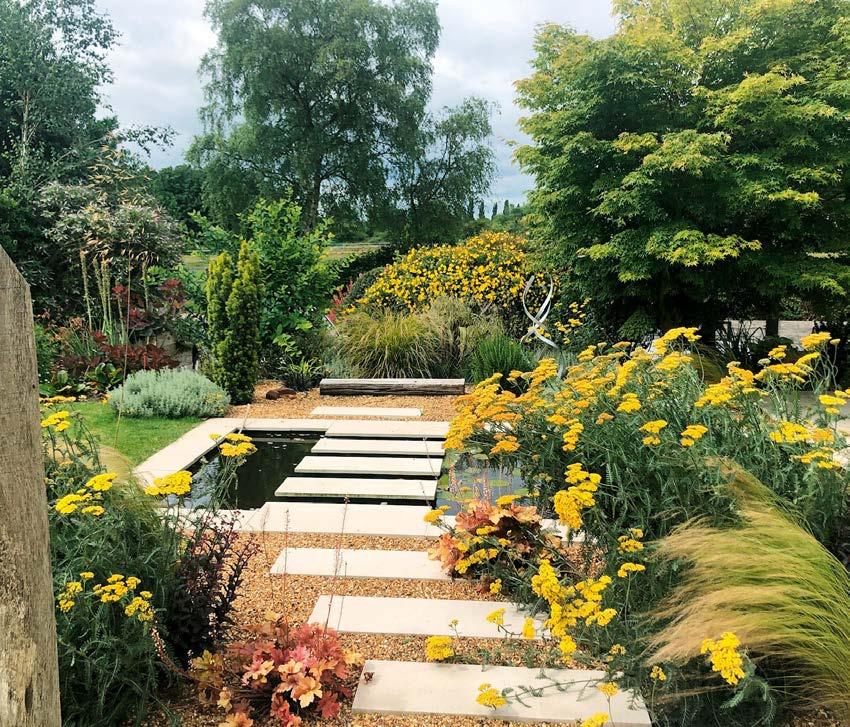
6 minute read
Elemental BEAUTY
Whether a country or a town garden, adding a water feature will bring light, energy and life-enhancing properties for all to enjoy
Aconstant muse of artists, sculptors and gardeners alike, water has long played an important role in gardens. An essential life-giving source for crops and blooms, over centuries it has become a design tool for individual expression, style and status. From the cool and serene courts of Granada’s Alhambra Garden and the exuberant fountains of the Palace of Versailles to the majestic Grand Cascade at Chatsworth House in Derbyshire, water can be manipulated in spectacular fashion. Today, in both town and country gardens, water continues to captivate designers and homeowners alike with its aesthetic possibilities.
Water Features For The Country Garden
Often generous in scale and enveloped by glorious untamed landscape, a country garden is the perfect setting for spectacular water features. Large pools, ponds and lakes look impressive, but also help embed a garden within its surroundings. Acting as a giant mirror, the reflective water concentrates the gaze and soothes the mind by highlighting the sky and scudding clouds overhead, as well as the surrounding trees, plants and landscape. Those looking to heighten the effect further may opt for a bold square or rectangular pond sharply framed in smooth stone paving.
A mesmerising focal point, it should be no surprise that these expansive areas of water quickly become places to linger. Garden designers Vanessa Hoch and Rachel Pocock of VaRa Garden Design explain: “Introducing water in a rural garden is a great way of bringing the surrounding landscape into the space. In a recent project, a well-placed bench on the other side of the water invites visitors to cross over, sit and enjoy the view and visiting wildlife.”
Freestanding water features can also act as pivotal points within a garden. From ornate tiered fountains and sky-searching jets to smooth modern spheres, there are endless designs and materials to choose from. Placed where pathways meet, at the far end of an avenue or overlooking an idyllic view, they add drama to their setting.
Inspired by the land
Observing the natural undulations of the garden can often prompt ideas. “If you have a sloping garden, you have the opportunity to create a ‘stream garden’ – effectively a series of ponds separated by waterfalls,” says Acres Wild designer Debbie Roberts. Creating a naturalistic-style pond or lake requires similar skills. “It’s crucial to incorporate marginal sloping shelves so that different aquatic and marginal plants can be added to soften the edges and provide a fabulous habitat for frogs, newts, dragonflies,” says Rob Jones, director of The Garden Design Company.
Pondering practicalities
Positioning a water feature is not a purely aesthetic matter, there are functional considerations too.
“Always to be considered, but often neglected, is the boring but important maintenance,” says renowned sculptor and water feature specialist David Harber. “Beware wildlife, algae and falling leaves, safety in terms of depth of water, splash (damp slippery surroundings) and frost and ice. All of these elements can be eliminated or mitigated by a well-designed and installed water feature.”
Future-proofing a desired water feature is prudent too. “When considering the type of water feature you would like to have, look into the installation and maintenance costs alongside what you want from the feature itself. They can range drastically from formal rills and cascades, wildlife ponds and brimming urns,” says garden designer Rae Wilkinson.
Lighting matters
Garden lighting has evolved over recent years, largely due to major advancements in the safe outdoor use of devices such as LEDs (light-emitting diodes). Smaller, brighter and more energy efficient than traditional bulbs, the latest products are sleek, discreet by day and offer varied effects and applications.
Luke Thomas, design director at John Cullen Lighting, says: “Water features are a wonderful medium to light as the movement and refraction create patterns which reflect on the surrounding area. Where a pool of water is not moving, submerged lighting typically gives an undesirable green underwater glow. A more interesting solution is to use the surface of the water as a reflective mirror. When lit, features located on the opposite side of the water appear in the ripples.”
Illuminating moving water also creates spectacular results. Thomas continues: “For a fountain, a bespoke fibre optic lighting system can be small enough to fit within the water supply pipes, so the whole plume is illuminated. A more standard solution is to use submersible lighting with a weighted base, to uplight through the water.”
POINTS TO CONSIDER WHEN PLANNING A WATER FEATURE IN A COUNTRY GARDEN
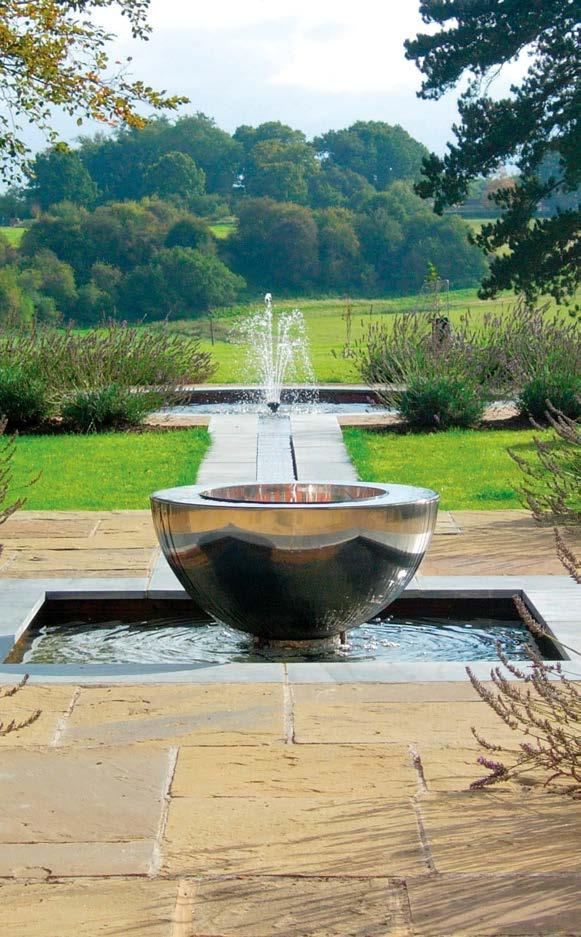
• Think big and use the space to create expansive pools and meandering streams.
• Borrow from the surrounding landsca e and reflect lanting trees hills and near structures
• Excavating large water features will result in vast amounts of waste soil. Plan to use this elsewhere in the garden as waste removal can ro e costl
• Position sculptural fountains and water features at e oints such as where aths and dri ewa s eet and near breathtaking vistas.
• f lanning a feature near the house echo architectural aterials finishes and details for a ti eless finish
• Running electrical wiring over distance to ower a water u and ond lighting is a professional job. Work includes e ca ating trenches ur ing armoured cabling and installing a separate switch or junction box.
LEFT Water clings and flows over the mirror-polished surface of this sculptural design, which is lit inside and from below.
Stainless Steel Chalice, from £28,168, David Harber
RIGHT A timber walkway and airy planting are star features in this idyllic stream garden by Debbie Roberts and Ian Smith of Acres Wild.
BELOW Loose planting and gravel surrounding the pale sandstone-edged pond create an inviting yet formal water feature in this design by VaRa Garden Design.
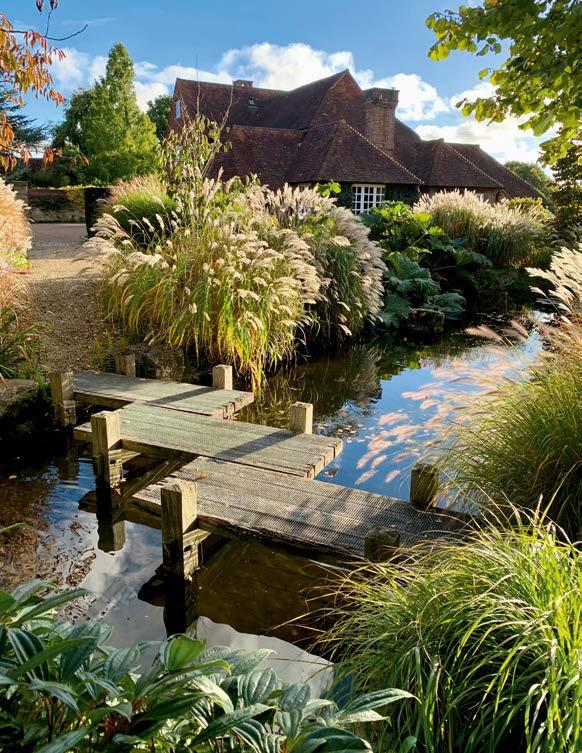
Water Features For The Town Garden
Town gardens tend to be defined areas enclosed by high boundaries. With different design and practical requirements to rural sites, these plots need to be space-efficient and multi-functional without comprising on style. Water features play an important part in the ambience of these gardens, so determining their format, scale and position is paramount.
Appeal to the senses
Engaging the senses is vital when designing a water feature for a townhouse garden. Often viewed at close quarters and appreciated from many different angles, designs need to be impactful without overwhelming the space. “Moving water brings sound to the senses which can be deeply soothing or a welcome distraction, bringing you consciously into the garden and perhaps taking the focus away from any noise pollution,” explains garden designer Rae Wilkinson.
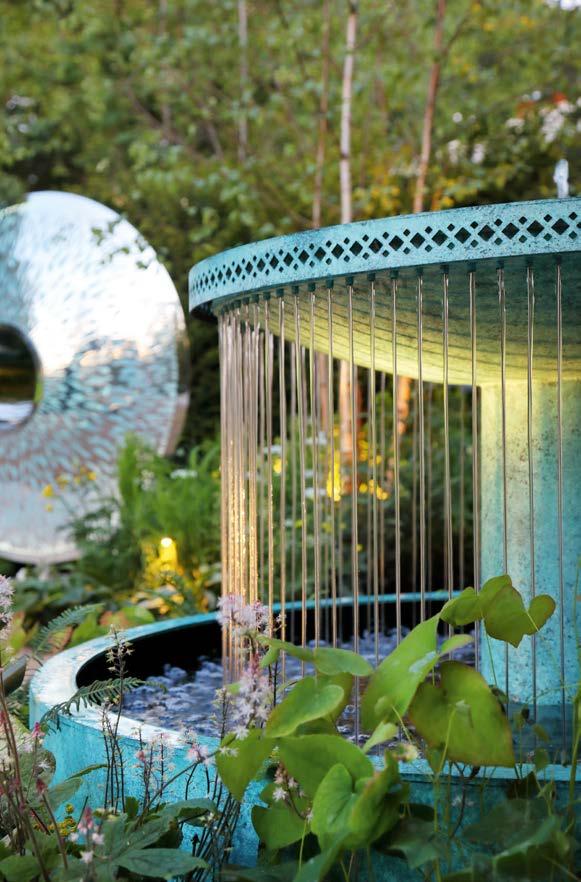
Space-enhancing qualities
Enjoying views from the house, these gardens are ideally suited to simplistic and bold water features. Showcasing both still and moving water, successful designs need to be sympathetic in scale and well thought through. “I always look to incorporate water into my outdoor spaces,” says landscape designer Adam Vertere. “While it is a must for increasing the biodiversity within a garden, I also like to explore the reflective qualities that a water surface can provide, especially in smaller spaces. As in a small room inside a house, it can increase the feeling of space.”
Considering key sight-lines from and through the house is helpful when positioning a new water feature. An effective way to blur interior and exterior spaces, it can help create a feeling of space and entice visitors out into the garden, even when darkness falls. “All water features benefit enormously from incorporating appropriate lighting, not only extending the hours of enjoyment, but also creating a totally different mood and character of the piece,” says David Harber.
An enriching experience
Whether admired up close or traversed by a stone or plank bridge, water in a town garden is hugely enticing and instantly soothing. “Crossing water is always an engaging element to add as part of a meander around
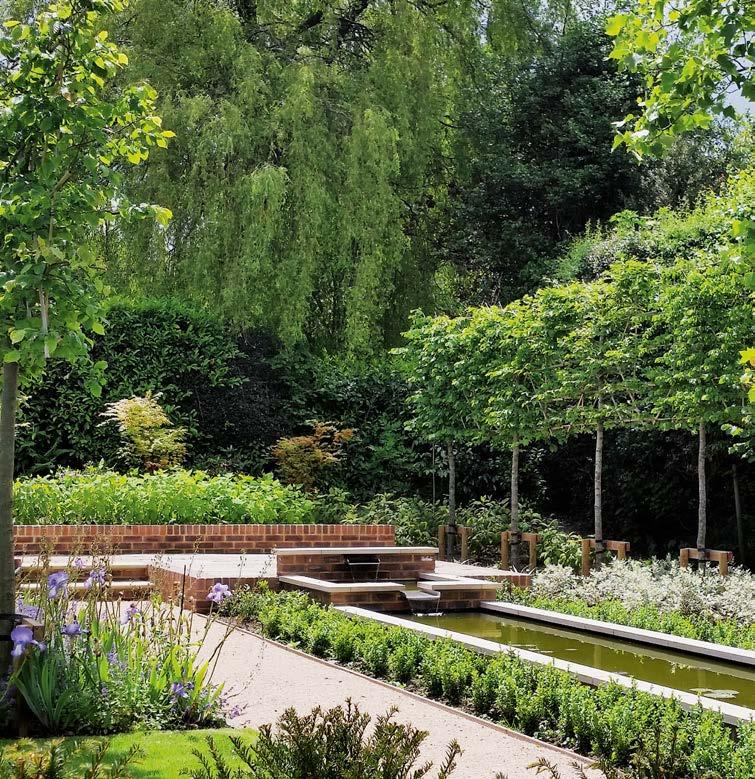
ABOVE Rae
Wilkinson’s contemporary design in Surrey includes tiered water flowing into a broad reflective rill. Overhanging paving creates a seamless finish. RIGHT Fibre optic lights can be installed within bespoke water features to create an exquisitely delicate effect. Lighting design by John Cullen. Mimeo Cascade, £35,744, David Harber
OPPOSITE the garden, be it with stepping stones or something more structural,” says Debbie Roberts of Acres Wild. Rills – narrow water-filled channels – are also popular with designers. Garden designer Tom Howard explains: “Rills can add drama to a pathway by running alongside or down the centre and even follow steps to create mini waterfalls.”
Designed by Lynne Marcus and built by The Garden Builders, a rear garden with long, narrow pool links this suburban Hampstead house with the heath beyond. The glasscovered seating area is reached by ‘floating slab’ stepping stones.
Not only people-pleasing, water features also attract wildlife and pollinators. “Our natural sandstone sphere features are designed for the water to run across the surface in a thin film, enhancing the colour and providing an ideal environment for insects,” says Foras MD Claire Brutnall. “The water moves slowly under gravity and is shallow enough for them to stand safely, cool themselves and drink.” ■
TOP A harmonious pairing of a narrow rill edged with wildflowers and smooth stone paving in this London garden designed by Tom Howard.
ABOVE This elegant feature remains moving even during freezing conditions, allowing birds to bathe and drink throughout winter. Copper Crucible Spa Water Feature, from £4,000, Foras
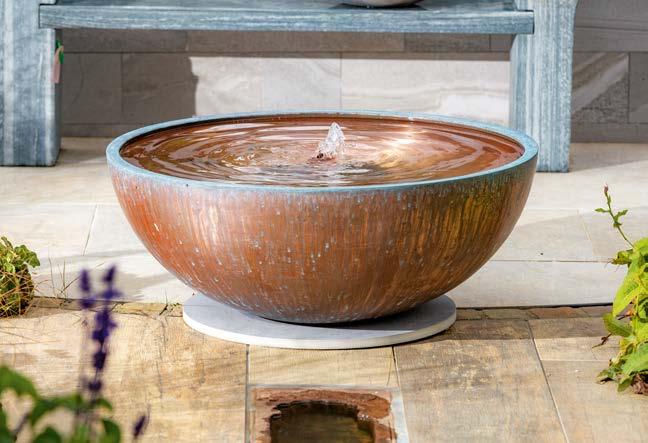
Points To Consider When Planning A Water Feature In A Town Garden
• Easy access to mains power makes plug-and-go, self-contained water features a quick and simple option.
• Think vertically and consider a textured water wall or falling curtain of water.
• Capitalise on smaller spaces by choosing sensory water features such as pooling bubble jets and water tables.
• Water features with a continual flow of falling water will disguise traffic noise and soften the sound.
• Maximise a steep sloping site by creating a tiered design – rills or water chutes and walls.









